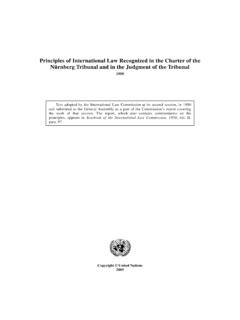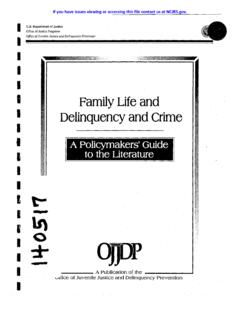Transcription of KOHLBERG'S STAGES OF MORAL DEVELOPMENT
1 Crain. (1985). Theories of DEVELOPMENT . Prentice-Hall. pp. 118-136. CHAPTER SEVEN. KOHLBERG'S STAGES OF MORAL . DEVELOPMENT . BIOGRAPHICAL INTRODUCTION. An outstanding example of research in the Piagetian tradition is the work of Lawrence kohlberg . kohlberg has focused on MORAL DEVELOPMENT and has proposed a stage theory of MORAL thinking which goes well beyond Piaget's initial formulations. kohlberg , who was born in 1927, grew up in Bronxville, New York, and attended the Andover Academy in Massachusetts, a private high school for bright and usually wealthy students. He did not go immediately to college, but instead went to help the Israeli cause, in which he was made the Second Engineer on an old freighter carrying refugees from parts of Europe to Israel. After this, in 1948, he enrolled at the University of Chicago, where he scored so high on admission tests that he had to take only a few courses to earn his bachelor's degree. This he did in one year. He stayed on at Chicago for graduate work in psychology, at first thinking he would become a clinical psychologist.
2 However, he soon became interested in Piaget and began interviewing children and adolescents on MORAL issues. The result was his doctoral dissertation (1958a), the first rendition of his new stage theory. kohlberg is an informal, unassuming man who also is a true scholar; he has thought long and deeply about a wide range of issues in both psychology and philosophy and has done much to help others appreciate the wisdom of many of the "old psychologists," such as Rousseau, John Dewey, and James Mark Baldwin. kohlberg has taught at the University of Chicago (1962-1968) and, since 1968, has been at Harvard University. PIAGET'S STAGES OF MORAL JUDGMENT. Piaget studied many aspects of MORAL judgment, but most of his findings fit into a two- stage theory. Children younger than 10 or 11 years think about MORAL dilemmas one way; older children consider them differently. As we have seen, younger children regard rules as fixed and absolute. They believe that rules are handed down by adults or by God and that one cannot change them.
3 The older child's view is more relativistic. He or she understands that it is permissible to change rules if everyone agrees. Rules are not sacred and absolute but are devices which humans use to get along cooperatively. 1. At approximately the same time--10 or 11 years--children's MORAL thinking undergoes other shifts. In particular, younger children base their MORAL judgments more on consequences, whereas older children base their judgments on intentions. When, for example, the young child hears about one boy who broke 15 cups trying to help his mother and another boy who broke only one cup trying to steal cookies, the young child thinks that the first boy did worse. The child primarily considers the amount of damage--the consequences--whereas the older child is more likely to judge wrongness in terms of the motives underlying the act (Piaget, 1932, p. 137). There are many more details to Piaget's work on MORAL judgment, but he essentially found a series of changes that occur between the ages of 10 and 12, just when the child begins to enter the general stage of formal operations.
4 Intellectual DEVELOPMENT , however, does not stop at this point. This is just the beginning of formal operations, which continue to develop at least until age 16. Accordingly, one might expect thinking about MORAL issues to continue to develop throughout adolescence. kohlberg therefore interviewed both children and adolescents about MORAL dilemmas, and he did find STAGES that go well beyond Piaget's. He uncovered six STAGES , only the first three of which share many features with Piaget's STAGES . KOHLBERG'S METHOD. KOHLBERG'S (1958a) core sample was comprised of 72 boys, from both middle- and lower-class families in Chicago. They were ages 10, 13, and 16. He later added to his sample younger children, delinquents, and boys and girls from other American cities and from other countries (1963, 1970). The basic interview consists of a series of dilemmas such as the following: Heinz Steals the Drug In Europe, a woman was near death from a special kind of cancer. There was one drug that the doctors thought might save her.
5 It was a form of radium that a druggist in the same town had recently discovered. The drug was expensive to make, but the druggist was charging ten times what the drug cost him to make. He paid $200 for the radium and charged $2,000 for a small dose of the drug. The sick woman's husband, Heinz, went to everyone he knew to borrow the money, but he could only get together about $ 1,000 which is half of what it cost. He told the druggist that his wife was dying and asked him to sell it cheaper or let him pay later. But the druggist said: "No, I. discovered the drug and I'm going to make money from it." So Heinz got desperate and broke into the man's store to steal the drug-for his wife. Should the husband have done that? ( kohlberg , 1963, p. 19). kohlberg is not really interested in whether the subject says "yes" or "no" to this dilemma but in the reasoning behind the answer. The interviewer wants to know why the subject thinks Heinz should or should not have stolen the drug.
6 The interview schedule then asks new questions which help one understand the child's reasoning. For example, children are asked if Heinz had a right to steal the drug, if he was violating the druggist's rights, and what sentence the judge should give him once he 2. was caught. Once again, the main concern is with the reasoning behind the answers. The interview then goes on to give more dilemmas in order to get a good sampling of a subject's MORAL thinking. Once kohlberg had classified the various responses into STAGES , he wanted to know whether his classification was reliable. In particular, he. wanted to know if others would score the protocols in the same way. Other judges independently scored a sample of responses, and he calculated the degree to which all raters agreed. This procedure is called interrater reliability. kohlberg found these agreements to be high, as he has in his subsequent work, but whenever investigators use KOHLBERG'S interview, they also should check for interrater reliability before scoring the entire sample.
7 KOHLBERG'S SIX STAGES . Level 1. Preconventional Morality stage 1. Obedience and Punishment Orientation. KOHLBERG'S stage 1 is similar to Piaget's first stage of MORAL thought. The child assumes that powerful authorities hand down a fixed set of rules which he or she must unquestioningly obey. To the Heinz dilemma, the child typically says that Heinz was wrong to steal the drug because "It's against the law," or "It's bad to steal," as if this were all there were to it. When asked to elaborate, the child usually responds in terms of the consequences involved, explaining that stealing is bad "because you'll get punished" ( kohlberg , 1958b). Although the vast majority of children at stage 1 oppose Heinz's theft, it is still possible for a child to support the action and still employ stage 1 reasoning. For example, a child might say, "Heinz can steal it because he asked first and it's not like he stole something big; he won't get punished" (see Rest, 1973). Even though the child agrees with Heinz's action, the reasoning is still stage 1; the concern is with what authorities permit and punish.
8 kohlberg calls stage 1 thinking "preconventional" because children do not yet speak as members of society. Instead, they see morality as something external to themselves, as that which the big people say they must do. stage 2. Individualism and Exchange. At this stage children recognize that there is not just one right view that is handed down by the authorities. Different individuals have different viewpoints. "Heinz," they might point out, "might think it's right to take the drug, the druggist would not." Since everything is relative, each person is free to pursue his or her individual interests. One boy said that Heinz might steal the drug if he wanted his wife to live, but that he doesn't have to if he wants to marry someone younger and better-looking ( kohlberg , 1963, p. 24). Another boy said Heinz might steal it because maybe they had children and he might need someone at home to look after them. But maybe he shouldn't steal it because they might put him in prison for more years than he could stand.
9 (Colby and Kauffman. 1983, p. 300). What is right for Heinz, then, is what meets his own self-interests. 3. You might have noticed that children at both STAGES 1 and 2 talk about punishment. However, they perceive it differently. At stage 1 punishment is tied up in the child's mind with wrongness; punishment "proves" that disobedience is wrong. At stage 2, in contrast, punishment is simply a risk that one naturally wants to avoid. Although stage 2 respondents sometimes sound amoral, they do have some sense of right action. This is a notion of fair exchange or fair deals. The philosophy is one of returning favors--"If you scratch my back, I'll scratch yours." To the Heinz story, subjects often say that Heinz was right to steal the drug because the druggist was unwilling to make a fair deal; he was "trying to rip Heinz off," Or they might say that he should steal for his wife "because she might return the favor some day" (Gibbs et al., 1983, p. 19). Respondents at stage 2 are still said to reason at the preconventional level because they speak as isolated individuals rather than as members of society.
10 They see individuals exchanging favors, but there is still no identification with the values of the family or community. Level II. Conventional Morality stage 3. Good Interpersonal Relationships. At this stage children--who are by now usually entering their teens--see morality as more than simple deals. They believe that people should live up to the expectations of the family and community and behave in "good" ways. Good behavior means having good motives and interpersonal feelings such as love, empathy, trust, and concern for others. Heinz, they typically argue, was right to steal the drug because "He was a good man for wanting to save her," and "His intentions were good, that of saving the life of someone he loves." Even if Heinz doesn't love his wife, these subjects often say, he should steal the drug because "I. don't think any husband should sit back and watch his wife die" (Gibbs et al., 1983, pp. 36-42; kohlberg , 1958b). If Heinz's motives were good, the druggist's were bad.






